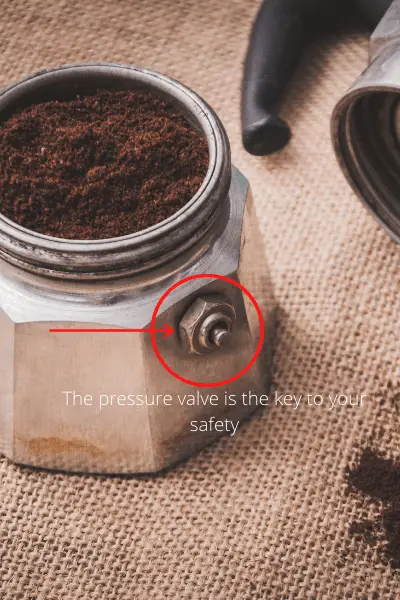Putting a closed container with water on a heat source sounds like a bad idea, doesn’t it? That’s pretty much what a moka pot is though. Can a moka pot explode and if so what can you do to prevent this?
In very rare situations a moka pot could explode if both the safety valve and filter are completely blocked/stuck. The safety valve and filter basket can get clogged up by deposits that build up with use over time. With proper cleaning and maintenance, these deposits can easily be prevented.
Let’s get a little deeper into why and how this can happen and how to prevent this from happening to you. Keep reading to find out.
Contents
Can a Moka Pot Explode?
The quick answer is; yes, a moka pot can explode under the ‘right’ circumstances, usually the result of a stuck valve.
In the lower part of a moka pot, the boiling water generates steam, creating significant pressure. In normal conditions, this pressure is what facilitates the brewing process by pushing water through the coffee grounds.
If for some reason (we’ll go into later) this pressure can’t escape quickly enough, there is a safety mechanism. you might notice a bronze-colored pressure valve on the side of the percolator boiler. This is the safety valve.
This pressure valve is designed to open and release excess pressure, preventing potential hazards. For a moka pot to explode, both pressure release methods must be obstructed. And this is a possibility and a good reason why you shouldn’t leave a moka pot unattended.
While the term “explosion” might evoke concern, it’s crucial to clarify that this doesn’t involve the metal container violently bursting and scattering shrapnel. Instead, other components in the moka pot are likely to fail before the cast aluminum container does. Usually, if this happens the top part pops off the bottom. Still not good but a little less bad.
While concrete data on moka pot explosions is hard to find, instances have been documented through pictures and videos online. It’s worth noting that this occurrence is not widespread; millions of moka pots are used globally, and explosions are far from a daily event.
Although the potential failure can be alarming and may result in coffee spilling, serious damage is rare. Preventive measures can significantly minimize the risk, making such incidents infrequent.
Fortunately, moka pot mishaps aren’t random; a few factors contribute to potential problems.

Are you not yet 100% sure how to brew good coffee with a Moka pot? Click here to find a step-by-step guide.
What Can Cause a Moka Pot To Explode?
As outlined above, a percolator can self-disassemble when the pressure gets too high. Usually, the pressure is relieved by pushing the water through the coffee and into the collector or, if that doesn’t work, through the pressure valve.
Let’s get into the causes of both those pressure reliefs not working.
Those are the reasons, but what can you do to prevent this? Keep reading below to find out.

How To Prevent a Moka Pot Accident
By looking at the causes, we can find some fixes that prevent bad things from happening with your moka pot. Here’s a list of the potential problems and their solutions;
Pressure Valve
The pressure valve is the safety mechanism that has to prevent bad things from happening so it’s key to make sure it’s working right.
If the valve seems stuck, the first thing to try is cleaning it, but replacing is also an option on some better brands.
Filter Flow
Of course, it’s best if you never have to use the safety fallback to begin with. While that’s not always possible, here are the best things to do;
Doing those things will mean the water will flow perfectly fine through the filter and the pressure is relieved as it should while brewing coffee. In case the pressure keeps relieving through the safety valve check the following things;
Does the safety valve keep opening? The valve itself might be too loose to hold any pressure at all. Here’s what to check.
In both cases, replacing the valve is the right solution.
Favorite Moka Pot Products
You don’t need many things to brew good coffee with a Moka pot. Here are the few things you need to make the best possible coffee.
- Moka Pot: Just buy a high-quality Moka pot from the get-go. The cheaper ones can be messy when brewing. Bialetti is the original and still one of the best with its classic looks. They cost a bit more than the cheap ones but these can last for decades and the parts that wear out are easily available for the Bialetti Moka pots. The 3-cup size is good for a single person (Amazon)
- Beans: Good coffee starts with good beans. You can’t make bad beans taste good. Espresso roast beans are good for a Moka pot and will get you closer to that typical espresso taste. Peet’s Coffee does a great 100$ Arabica espresso roast. Give it a try, you can get it here on Amazon
- Grinder: Using whole beans means you need to grind them at home. This improves the taste because the grounds are much fresher. A Hario Slim (Amazon) is a great starting point for the starting home barista. If you want a good hand grinder for a good price, check out the TimeMore C2 (Amazon)
- Scales: To get consistent results, a set of accurate scales is essential. Check out this Apexstone scale (Amazon). I’ve been using it for more than a year and while it doesn’t look the sleekest, it’s cheap and just as accurate as more expensive coffee scales. It just reacts a little slower.

